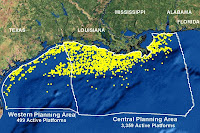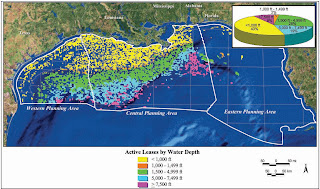With Federal regulators approving a new Gulf of Mexico oil well and the Canadian government continuing to support deepwater drilling off its own coasts, it looks like business as usual for the oil industry despite media coverage of BP’s ongoing ecological disaster.
Even if the media debate switches to the realities of peak oil and the need for renewable alternatives to declining fossil fuels – or indeed the lack of regulation of the oil industry in the US, which has been compared to the financial sector before the 2008 credit meltdown – it seems a fair bet that it won’t dull our appetite for oil.
An Associated Press report Wednesday (June 2) reported that “the first new Gulf of Mexico oil well since President Barack Obama lifted a brief ban on drilling in shallow water” has been given the go ahead. It’s only deepwater projects that remain temporarily frozen. The item, APNewsBreak: Feds approve new Gulf oil well off La, states:
The Minerals Management Service granted a new drilling permit sought by Bandon Oil and Gas for a site about 50 miles off the coast of Louisiana and 115 feet below the ocean's surface. It's south of Rockefeller State Wildlife Refuge and Game Preserve, far to the west of the Deepwater Horizon oil rig that triggered the BP spill.
Obama last week extended a moratorium on wells in deep water like the BP one that blew out a mile below the surface in April and is gushing millions of gallons of oil. But at the same time, the president quietly allowed a three-week-old ban on drilling in shallow water to expire.

Anyone wanting to understand the issue should turn to an 87-page Minerals Management Service document, Deepwater Gulf of Mexico 2009: Interim Report of 2008 Highlights. Essentially, the US Department of the Interior’s Minerals Management Service controls leasing of offshore oil and gas rights in the nation’s waters – these are sold to the highest bidder. This, which defines deepwater as anything in a depth greater than 1,000 feet, states:
In February 1997, there were 17 producing deepwater projects, up from only 6 at the end of 1992. Since then, industry has been rapidly advancing into deep water, and many of the anticipated fields have begun production. At the end of 2008, there were 141 producing projects in the deepwater Gulf of Mexico.
If 141 producing deepwater projects in that area seems larger than expected, note that there are many more leases on oilfields in the area – 7,310 active leases in 2008 - and that the trend is towards ever deeper water. The document continues:
Over the last 15 or so years, leasing, drilling, and production moved steadily into deeper waters. There are approximately 7,310 active leases in the U.S. GOM, 58 percent of which are in deep water. (Note that lease statuses may change daily, so the current number of active leases is an approximation.) Contrast this to approximately 5,600 active GOM leases in 1992, only 27 percent of which were in deep water. There was a maximum of 31 rigs drilling in deep water in 2008, compared with only 3 rigs in 1992. Likewise, deepwater oil production rose about 786 percent and deepwater gas production increased about 1,067 percent from 1992 to 2007. Production from seven deepwater fields began in 2008, including Thunder Horse, the largest daily producer in the GOM.
Much of the future development is likely to be at depths much greater than BP’s well in the Mississippi Canyon – which is in 5,000 feet (1,500 m) of water. As the Deepwater Gulf of Mexico document states: “Shell Oil Company set a world water depth record in drilling and completing a subsea well 9,356 ft (2,852 m) below the water surface in the Silvertip project at the Perdido Regional Host facility in Alaminos Canyon.”
It contains the following chart, updating the 2006 map by including depth:

On the subject of pdf documents, another interesting one is BP's Initial Exploration Planfor its operation in Mississippi Canyon 252 – the blowout well that’s currently spewing anywhere between 12,000 and 25,000 barrels of oil into the Gulf each day. This, which can be seen on the Mineral Management Service website, is dated Februrary 2009. The constant theme of this is that, while BP recognized the potential for a blowout, it was not required to come up with a plan to deal with one:
2.7 Blowout Scenario A scenario for a potential blowout of the well from which BP would expect to have the highest volume of liquid hydrocarbons is not required for the operations proposed in this EP.
7.1.5 Oil spill response
discussion – a discussion of response to an oil spill resulting from the activities proposed in this plan is not required for this Exploration Plan.
7.2 Modeling report
A model of a potential oil or hazardous substance spill is not required for the activities proposed in this plan.
This document also includes a rather interesting table:


Already, an estimated 20 million to 40 million gallons of oil has spewed, eclipsing the 11 million that leaked from the Exxon Valdez disaster.
BP is estimated to have already spent a billion dollars on the oil leak, and estimates suggest it will cost a further two billion or so. Adding to the company’s woes is US Attorney-General Eric Holder’s announcement of civil and criminal investigations. If negligence can be proved, corporate legislation that would cap the company’s liability at $75 million no longer applies. According to press reports, “the US government could seek to fine BP up to $4,300 for every barrel leaked.”
BP’s stock price is tumbling as a result – dropping 15 per cent Tuesday and wiping $17 billion off the company’s value. According to a report in the Canadian Globe and Mail newspaper, U.S. probe, surging costs threaten to sink BP, the oil giant now “ finds itself in an epic battle for its future.” It continues:
BP's market value has shrivelled under the constant onslaught of negative headlines and growing concerns that the company will have to finance a massive clean-up and compensation effort, plus face billions of dollars in fines.
Already down 30 per cent from its pre-spill level of $60 (U.S.), BP shares plunged in trading in London and New York on Tuesday, losing $6.43 to close at $36.52 (U.S.) on the New York Stock Exchange . Since the blowout on April 20, BP's market value declined by $63-billion (U.S.), raising takeover speculation.
Takeover is unlikely, according to market experts, with regulators supposedly not keen on bigger oil companies – and anyway, any purchaser would have to write off the rapidly growing debts from the Gulf disaster. What’s more likely is that BP, which operates in 30 countries with 80,000 employees, would have to sell off elements of the company to survive. There has even been speculation that the US government could nationalize BP.
An item in investors website Daily Profit Blogdraws an intriguing parallel between BP’s alleged practices before the Gulf blowout and those of US financial companies before the 2008 “credit crisis.” This states:
BP itself is under siege, too. The stock is in a virtual freefall as repeated efforts to cap the leak have failed. It could be months before the leak is stopped. Costs to the company could hit $22 billion. And that’s if BP didn’t do anything wrong.
It’s inevitable that BP will be found in violation of Clean Water and Refuse Act laws. But there could be criminal charges coming, too. The New York Times has recovered internal documents that suggest there were “serious problems and safety concerns” with the Deepwater rig. BP is also being investigated for lying about its ability to deal with oil spills. And not only that, BP may have been misleading regulators and taking shortcuts to get the rig working.
It seems clear that, at best, BP acted recklessly. And if you’re starting to see parallels with the way financial companies ignored risk and deceived regulators before the financial crisis of 2008, you’re not alone.
The industry as a whole is already suffering as a result of the Gulf disaster. (Not as much as the ecologically fragile wetlands, used by three quarters of US waterfowl and ninety per cent of the Gulf's marine species.) Insurance premiums for deepwater drilling “already jumped 40% and may rise further if U.S. lawmakers raise the liability cap for oil spills.”
But this does not mean the end of deepwater drilling - much of the web speculation in this area fails to consider the extent of Gulf of Mexico operations. And neither is it likely too, in all reality, mean the end of BP - a shareholder revolt, on the other hand, is quite likely once the spill is cleared up.
BP’s Tony Haywood faced City of London investors yesterday, by webcast. According to the UK Daily Telegraph newspaper, BP oil spill: Tony Hayward faces the City, he faced a noted lack of tough questions about the company’s future.
At one point, Hayward admitted the financial ramifications would be “severe”. But at the same time, he implied there would be no cut backs in spending – suggesting that BP’s strong cash flow would make whatever has to be paid out this year seem like pure pocket money.
As one of my colleagues remarked: “His company’s just scattered oil over the most litigious country on earth, the world’s most powerful man is breathing down his neck, and that call sounded all business as usual”.
It’s interesting to note that “Hayward says he “doesn’t think” the extra costs of safety improvements will make offshore deepwater drilling prohibitive.”
Meanwhile, the deepwater oil is going on as usual in Canada, according to the Globe and Mailnewspaper.
Newfoundland and Labrador is proceeding with the high-risk game of oil exploration in ultra-deep water, as regulators in the province express confidence in industry’s safety practices despite the ecological catastrophe of BP PLC’s Gulf of Mexico blowout.
Canada’s East Coast is now the only region in North America where oil companies can continue to drill deep-water exploration wells after President Barack Obama last week ordered the industry to suspend such operations in the Gulf of Mexico, pending a review of the BP disaster.
Simply put, if one of the largest publicly controlled oil companies (BP revenues are behind only to RoyalDutch Shell PLC and Exxon Mobil Corp.) finds itself in such an expensive mess over a single deepwater oil accident, then the industry will find itself in a terrible, dammned-if-you-do, dammed-if-you-don’t position. They have to go where the oil is, but their only options are either the under-performing oil sands or else technically challenging deepwater, where any error could see the company literally fighting for its survival.
In March, Jim Mulva, CEO of ConocoPhillips admitted that seeking new oil reserves was not a money making venture. We might well see a future of a handful of super-sized oil companies, or else nationalized oil producers serving government’s requirements of keeping industry running and the military mobile rather than seeking to make a profit on the open market.
Gulf spill won’t dampen U.S. appetite for oilThe Peak Oil Crisis: After the spill
No comments:
Post a Comment